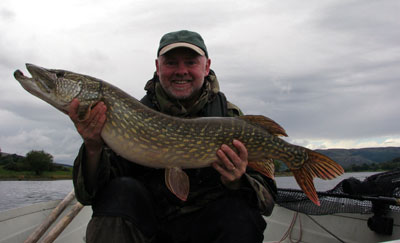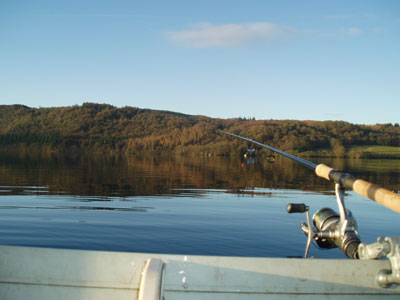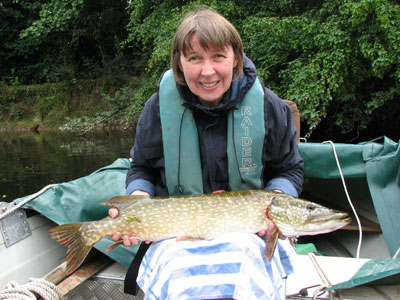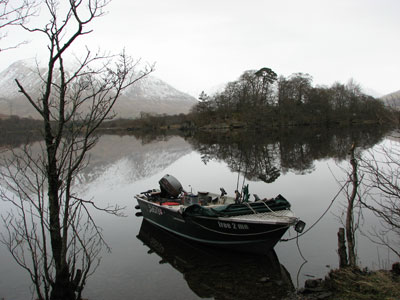So Why Boat Fish?
Now while I really enjoy my boat fishing, like most people I have limited opportunities to do it. As a result, most of the fishing I do is from the bank. Why should it be then that a great many of the biggest fish I have caught have been caught from a boat, or at least when a boat has been used? Some of the advantages offered by using a boat are fairly obvious while others are a little more subtle. Let’s take a look at a few of them.
Distance
Ever sat blanking on a big water while watching shoals of fish turning over well out of casting range? I know I have, lots of times. It goes without saying that the very best way to get at fish like this is with a boat. There are a number of other clever techniques that can be used to fish at long range of course; drifting baits, ballooning baits and bait boats are the main ones. The use of a boat however, allows the angler to pinpoint exactly the area to fish in and, in some cases, enables him to identify the very cause of all the activity. I well remember a day on Castle Loch at Lochmaben some years ago when a friend and I spotted a huge shoal of big bream rolling some two hundred yards from the bank. We got out there in a boat and discovered that the fish were congregating in an area that had a large underwater feature, a rocky mound rising up some eight feet above an otherwise featureless lakebed.
 |
|
A lovely fish taken whilst trolling between swims |
Bream, especially big ones, are a species that seems to favour the middle of the lake and I have always found a boat to be invaluable when fishing for them. Often it isn’t necessary to actually fish from the boat, but if one is available it makes the arduous task of finding a swim, clearing it of weed and baiting it so much easier. The baiting up in particular is a lot more effective when done from a boat, since bait can be concentrated into a tight area and can be introduced in large quantities – so often necessary when a big shoal of bream is likely to arrive. Once the hard work is done it’s easy to fish to a baited area from the bank or even to sit in the boat and fish it with a float.
The ability to fish effectively at great range is most useful on shallow waters where feeding grounds may be found way out in the middle. Gravel pits, sand pits, broads and estate lakes fall into this category though mid-water shallows may be found on almost any water. Larger glacial lakes and big reservoirs are often too deep to be worth fishing at great range but don’t ignore those surface layers. Pike, rudd, carp and others can sometimes be found out in the middle feeding on the surface over very deep water. Situations like this may have to be fished on the drift or by trolling, since anchoring and fishing effectively in very deep water presents real problems.
Fishing at long range seems to work particularly well on hard-fished waters. There is a belief that some species such as carp and pike can be driven away from the bank due to angling pressure. The fish move out of range to the safer areas in the middle. This behaviour is mirrored in the next boat-fishing advantage, that of accessibility.
Accessibility
A more important aspect of boat fishing is that it suddenly opens up those areas which you always wanted to fish but just could not get to. This type of area need not be very far out at all but has some kind of obstacle which prevents it from being reached from the bank. The great attraction of these areas is simply the fact that they cannot be fished. Fish feel safe here, usually because the obstacle provides sanctuary both from anglers and from predators of one form or another.
 |
|
I might fish ten or more spots |
Rivers in particular often have large areas which are quite inaccessible from the bank. This may be because of bankside vegetation, private land or simply because they are too far to walk to. I have some excellent examples of this. One area of the Yorkshire Ouse where I used to fish is right in the centre of the city of York. There is a stretch there that is quite unfishable from the bank due to the buildings whose walls drop sheer into the water. This is one of the best pike fishing stretches on the river and my friends and I spent many hours fishing here catching big pike while shoppers and business people throng the streets on the pedestrian walkways high above. This is great fun as often a cheer or a round of applause goes up when a big fish is boated.
Sometimes the accessibility issue is a subtle one and a shift in position of just a few yards is all it takes. Another fine swim on the Ouse exists where a culvert flows into the main river. This swim is accessible from the bank and many people fish it but they seem to catch mainly jack pike. Approach the same swim by boat and it becomes possible to fish just a little further downstream in the deeper water. Here is where the big pike lie and they can be caught fairly easily but the right spot can’t be reached from the bank due to the overhanging trees that get in the way.
It’s not only pike that are sometimes hard to get at. A spot my son and I found on the Welsh Dee last winter consisted of a steady glide alongside a dense reed bed. Here, the river’s big roach lie and the use of a boat means not only that the run in which the fish live can be reached, but also that feeding and trotting the swim becomes child’s play. Bank-bound anglers may be fishing quite nearby but because of the obstacle of the reeds, the very best of the fishing is denied them.
Mobility
This, in my view, is what really gives boat fishing the edge. Quite simply it is the ability to fish so many different areas in one day that enables the boat fisherman to really locate the fish. A typical days deadbaiting for example will see me fish around a dozen swims, some of them for no more than twenty minutes, and these places may be miles apart! Imagine trying to do this when bank fishing. Packing up a load of gear, trudging for half an hour and then setting it all up again lathered in sweat! Chances are that you would spend an age recovering from the effort before you wet a line.
What’s more, when boat fishing there is no need to spend time tackling up each time you move. It’s just a case of setting the anchors and casting in. This mobile approach has paid dividends for me many times. Indeed, it’s often the case that I will catch within moments of arriving in a new area and then move on only to do the same in the next swim.
 |
|
My wife, Clare, with a pike caught from a |
Increased mobility works not only because it enables you to find the spots where the fish are, but also because it enables you to find the spots where the fish aren’t – and eliminate them! The move and stop approach works well but there are several methods which allow the angler to fish while on the move. This is a great way of homing in on the most productive areas and on occasions, turns up good swims quite unexpectedly. I’m talking here mainly about fishing for predatory fish and in particular, pike. The fully mobile approach splits into two main categories, drifting and trolling, both of which will be covered later in this series.
Once the fish have been found like this, the angler has a choice to make. If the type of fish you are after are shoal fish like bream, roach or many other cyprinids, it makes sense to stay in the area and get the best out of it. If you have chosen well you should be able to enjoy hectic sport and go home tired but happy.
Predators such as pike or catfish tend to lead a more solitary existence and demand a different approach. In this case it is usually best to extract the best from a swim before moving on to the next likely area. This is likely to be something of a hit and miss affair if you are starting out on a new water but after fishing it for a month or two you will build up a portfolio of swims. After a while you will even get to know which spots fish best at certain times of the day. A typical day on the Ouse would see me start off on a certain wide, silty bend where I know the fish will always be found at first light. I usually end the day at the mouth of a marina where I know the fish often feed as the boat traffic subsides and the light starts to fade. In between the two I have a variety of places such as culverts, deep holes and bridges which I may fish once, twice or even three times during the day.
There is one thing to guard against when adopting this approach. You should concentrate on a fairly small area of water in order to get the best out of it. Trying to cover too much water will result in you spending so much time on the move that little time is left for the actual fishing. What’s more, you could end up as two friends of mine did, with a breakdown ten miles from your car and no means of getting back. This turned out a disaster for them, resulting in the loss of their boat when it was stolen after they had been forced to abandon it for the night.
 |
|
Huge glacial lakes are very much
|
Seclusion
All of the advantages I’ve outlined above demonstrate an angling edge – an aspect of boat fishing which can improve your chances of catching. However, there’s more to fishing than just catching fish as they say and when it comes to enjoying your environment, the boat comes into its own. You might think your local river is heavily fished but see it from a boat and you’ll get a different view. I have found it possible to travel for mile after mile on such rivers as the Aire, Ouse and Dee without seeing a single angler. Here, the absence of people brings the very best out of the wildlife with kingfishers, herons and a host of small mammals providing a private display.
There we have it then. This latest offering is designed to give non-boaters an idea of what they might be missing and perhaps, to give the newcomer to boating some pointers as to how he can get the best out of his boat.
Next article, I want to talk about the essential differences between bank and boat fishing, how it should affect your choice of tackle, including some specialist items, and what a difference it makes to the overall approach.










